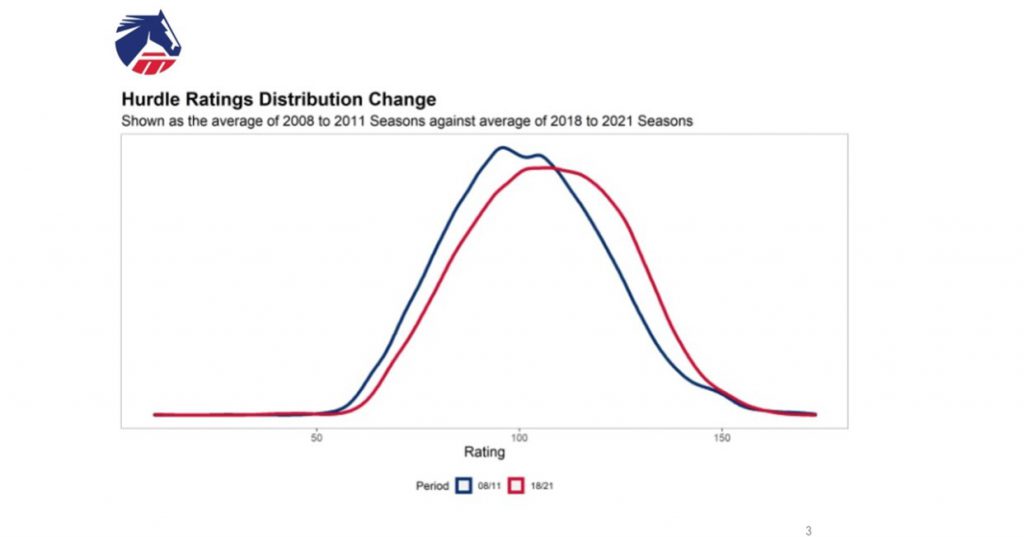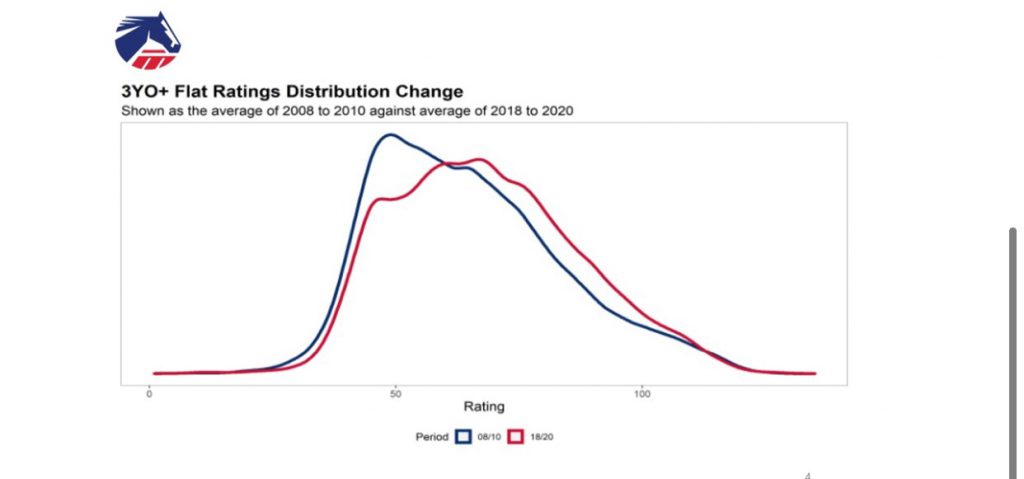BHA Jumps Handicap Review
02 Sep 21
As part of the BHA’s Quality Jumps Review that was instigated after the 2021 Cheltenham Festival, the Handicappers pledged to undertake a review of their work based on detailed statistical analysis – that process is now reaching its conclusion and the object of this paper is to highlight the main area of interest and our planned course of action to rectify the situation, writes Dominic Gardiner-Hill, Senior Handicapper of the BHA.
One of the main areas of study was to look at the distribution of all ratings across both the hurdle and chase files and the results are displayed below. The titles of each graph are self explanatory, whilst I have also included the distribution of 3yo+ within the flat ratings file for comparison.
Taking both the chase file (above) and the hurdle file (below) and comparing the average ratings of the seasons covering 2008-2011 against the seasons covering 2018-2021, it is clear to see that there has been a change in the distribution within certain areas of both files – in short, there has been an upward movement of the horses located in the middle part of the files, causing the “bulge” to move higher up the ratings scale.
This, of course, largely represents the area where the younger, progressive horses who are working their way up the ratings file coincide with the older, regressive horses who are starting to work their way in the opposite direction

In contrast, the distribution of the 3yo+ within the flat file has a much more statistically acceptable shape to it – from middle to bottom rather than middle to top as in the jumps files.

After discussions within the Handicapping team and other involved parties within the BHA, the decision has been made to address this issue basing the process on the analysis provided. The objective being to get the file distribution back to where it was (or close to where it was) during the 2008–2011 period – it was then a case of deciding how.
Three options were considered:
- A manual review of ratings to take place during the quieter two weeks of August when there was minimal Summer Jumping – having seen the number of horses involved (over 4,000) and the disruption it would cause to results and entries during this period it was discarded
- An automated review done by computer on a given date – this, however, largely took away ownership and responsibility from the Handicappers and it was felt it may throw up inconsistencies
- An organic process in which the handicapping team made subtle changes to certain areas of their methodology to meet the required objective by an agreed date.
After much debate we have decided to go with option 3 which has two major advantages over the others:
- It causes minimal disruption to the day to day running of jumps racing
- It allows the handicappers to take responsibility and be able to justify every amendment made
There will be no “seismic” change in handicapping methodology – the basics (recent form, relativity between horses, profile, success rates, etc) will stay in place but the following actions will also be followed:
- More generous drops where appropriate for older/regressive/ non-winning horses – this will entail certain 1-2lb drops becoming a 2-3lb drop, 2-3lb drops becoming a 3-4lb drop and so on.
- Based on the analysis provided, start certain sections of the novice hurdle division on lower opening marks (final details to be confirmed)
- Recalculate BHA Race Standards where appropriate
- Take horses off the ratings file who haven’t run for 6 months rather than the current 9 months – thus allowing the handicapper to assess their handicap mark when entered.
- More rigorous “back handicapping”
To help facilitate the above the handicappers will:
- Use an analysis based list of horses, drawn up when we were considering an automated review, as a guide but with human input.
- More rigorous file analysis on a more regular basis, both flat and jumps, to make sure stability is maintained.
- Look into the possibility of an annual analytical review of the file during August in readiness for the new season
We have set ourselves a target date of January 1st 2022 to complete this process and progress will be monitored on a weekly basis involving a number of analytics – this will obviously allow us to make sure we stay on track over the coming months to achieve our objectives by that date

